Schlock and Awe: An Analysis of Until Dawn
By gamer_152 0 Comments
Note: This article contains major spoilers for Until Dawn and the films Wendigo, The Last Winter, and The Descent.
Most games are on some level about the application of knowledge. As we work our way through interactive entertainment, we build mental maps of levels, memorise move sets, learn the timing of jumps, and more. Almost all games contain frequent tests of our understanding of their worlds and systems and reward us when we display that understanding. At first blush, Until Dawn does not appear to be that kind of game; it doesn't contain any enemies with weaknesses to exploit or units with areas of expertise to memorise. However, if we look more closely, we can see Until Dawn as a game that lets us use knowledge from collectables, our previous forays into the horror genre, and earlier playthroughs of the title to gain mastery over it. By employing these types of knowledge, we can predict where the characters are likely to encounter peril and twist their fates as we see fit. Until Dawn's greatest innovation is that while other games mostly have us use our knowledge of their systems to change their systems, this game lets us apply our knowledge of its story to change its story. To understand this in full, we must take an in-depth look at those three methods we can use to gain foreknowledge of the events of the game and how they interact with Until Dawn as a whole.
1. Totems and Clues
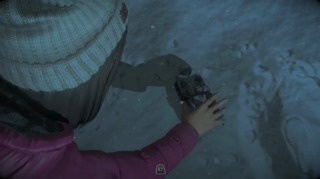
Of all the ways the game has of conveying foreknowledge, the totems are the most conceptually straightforward, but they're also the one with the most obscure origin. One-half of Until Dawn's writing team was horror industry veteran, Larry Fessenden. Fessenden had previously written, directed, and edited the 2001 horror film Wendigo. In it, a child by the name of Miles receives the gift of a totem from a Native American shopkeeper, and the ending scene of the movie consists of Miles clutching onto the totem, experiencing visions of the mythical Wendigo killing another character. You don't have to take a big leap to see how Fessenden got from that to the totems in Until Dawn.
They're an original mechanic and feel convincingly magical due to the way they break the fourth wall and deliver information it would be impossible for the characters to unearth naturally. However, the totems also require exploration to discover, and exploration is an activity the game discourages. Not only is character movement sluggish but hard cuts between the game's camera angles break a sense of fluid motion and can make it hard to orient yourself within a location. In one shot, holding "up" on the control stick may move your character North, but the second the game switches to another shot it might start moving them East.
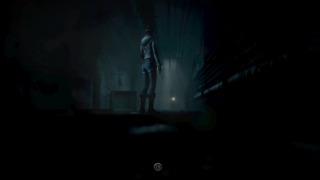
Many have compared Until Dawn's camera techniques to those in the original Resident Evil, but while Until Dawn and Resident Evil have similar camera design, they use that design to create different kinds of horror. Both aim to instil tension by not letting you see what's around the next corner, but Resident Evil also features a combat system, and the camera is designed to make you feel vulnerable in the face of the enemies you face in combat. Until Dawn doesn't have those same mechanics; similar to a film, it uses its camera angles more in service of shot composition. The game artistically constructs an ominous atmosphere through tricks like having the camera low to the ground in the basement or positioning it behind a skeleton in a sanitorium corridor. It creates some striking images that you can't find in other games, but not every shot can be a masterpiece. Much of the time the camera is there just to establish a location and show us how characters and objects are placed within it. In these cases, the trade-off of easy navigation for cinematic presentation doesn't get the game anything except making it awkward to try and look for totems, clues, and scraps that fill out the game's plot.
Many of the game's nooks and crannies don't have anything to be found in them anyway. In the language of games, alternate paths and sections of levels that don't serve the core gameplay are invitations for players to explore and find side content in, but in so many cases Until Dawn sets up these flags for collectables and then does not deliver. Exploring space behind the camera or choosing to take a less obvious path to your destination frequently nets you nothing. We'll talk about why the game maps seem to have so many superfluous pockets of space in the next section, but for now, all you need to know is that they send the message that exploration will not lead to reward. Even if you can innoculate yourself against that message, you then have to decide whether finding the totems is worth enduring all the aimless wandering that you can only do at the game's turtle-slow walking speed.
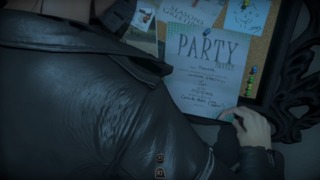
Everything that we can say about the frustration of trying to find the totems we can also say about trying to locate the game's other collectable item, clues, although we should keep in mind that they take a slightly different role in expanding the narrative. Note that all of Until Dawn's collectables are about developing the story precisely because it's a story game and the connection of these collectables to the larger narrative gives them a little more meaning than the random side-trinkets of other games. The totems and clues also complement each other nicely. The former look forwards while the latter look backwards.
2. Previous Playthroughs
The game encourages replays by being a short experience with a high price, by having collectables you can't go back to, and by having multiple story branches to climb. Players that have already completed the game once and play through a second time will have a better idea of how to save or doom the characters they want, as well as a more informed perspective on the events that unfold. This is one of those pieces of media where details that seemed like window dressing on the first play can be seen as relevant and foreshadowing the second time around. However, you can't excuse that there is so much window dressing on your first outing with Until Dawn. On that maiden voyage, the game's myriad inside nods don't feel like they add constructively to the story and even when you can see them in a richer context, you have to retread so much that's already familiar to get to them.
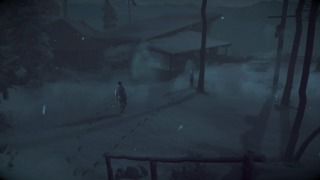
You end up not only slogging through the same environments and puzzles again but replays only draw attention to the vast gulfs in the game that have almost nothing of any interest in them. Many rooms are only sparsely populated with scenery and items you can interact with, and one reason Until Dawn may have numerous areas that serve little purpose is that it didn't start life as a narrative vehicle. The original Until Dawn[1] was a puzzle and shooting-driven game for the Playstation Move. You can still feel it in the game's motion controls and assorted tasks revolving around getting the power back on in various buildings. A lot of gameplay must have been removed and going light on the gameplay is a decision that can vastly improve a story-focused game, but only provided you put something just as complete in its place. I'm getting a little speculative here, but it's all too easy to believe that in Until Dawn's transformation from gameplay game to story game, more was taken out than got put back in.
Replaying the game also reveals how little the plot changes in reaction to your choices as the player. It doesn't so much feel like you're steering the events of the story as it does that you're flipping switches to alter a few details in someone else's story. It's a criticism that's been levelled at a lot of other narrative-driven games, but those games don't actively encourage replays in the way that Until Dawn does and Until Dawn is far more guilty of this sin. Just as the gaps between eye-catching scenery and events that advance the plot are too long, so are the gaps between anything that can push or pull the characters one way or the other. This is partially a consequence of the game's structure in which the focus is switched between characters who are mostly either alone or with only one other person. It's a great technique for ensuring exploration of characters without them being drowned out by other personalities, and it's an intelligent way to ensure that the game can have a large cast without that cast giving any individual character too much safety. However, it also results in fewer opportunities for us as players to take actions which will affect the group as a whole. It only worsens the situation that the average character choice in this game has so little to say.
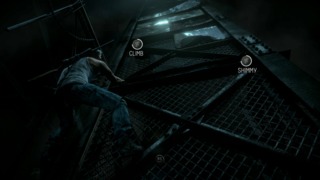
The majority of other branching narrative games constantly have you make decisions about what demeanour or interests you want your character to have, but in Until Dawn many forks in the road are purely practical ones with so little to say about the characters or you as a player. You can go for extended periods without making story decisions that are any more than whether you want to go left or right at an intersection or whether you want to climb a cliff face slowly or quickly. Until Dawn is more concerned about telling you the tale it wants you to hear, rather than letting you collaborate with the authors to build a story between you. These may be the fingerprints of the writers' history in cinema; the tautness of the plot is likely an attempt to make sure the game adheres to an ideal direction for the story and characters, mimicking the patterns of film. However, if you want to use a filmic structure for your storytelling, you're probably better off not opting for a game as your chosen medium. At least, not one where the player is making story choices, and not one where the player is so proactively encouraged to replay.
3. Knowledge of Horror Tropes
This one doesn't come into play as much as the previously mentioned features, but even basic familiarity with the horror genre gives you an edge in Until Dawn. If you know the genre has a history of heroic animal companions which are sensitive to supernatural threats, you know having Mike befriend the wolf he finds will probably provide an ace up your sleeve. If you've seen what happens when characters in creepy settings wander away from the group, then you know that having Ashley stray from the pack is probably going to place her in the path of danger.
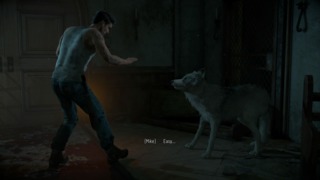
Most horror games have enough overlap with horror literature and films to make them appealing to people who are fans of the wider scary story pantheon, but these moments in Until Dawn go one step further in that they reward players precisely for their fandom of horror fiction. As a player, it's a bit like being presented with a horror quiz where you can feel knowledgeable for getting all the answers correct, but the consequence of getting those answers right is sometimes much more meaningful in Until Dawn than it is in any pub trivia. You're not just notching up another point; you're controlling the actions of a protagonist and deciding their fate. There are also plenty of scenes in which you can anticipate what's going to happen next and just feel smart about it, even if you can't directly affect the outcome of the events. You can work out that the hooded figure which chases Sam and Josh looks cheap enough that it's just someone playing a prank and deduce that Mike and Jess deciding to get frisky in a secluded cabin with a killer on the loose leads to an inevitable attack.
Of course, to be this kind of transcendent quiz on horror tropes, Until Dawn has to patchwork itself together from horror tropes which leads to numerous problems, the most obvious being that it makes Until Dawn a character-driven game where the characters are stereotypes and a thriller title where the plot is predictable. Co-writer Graham Reznick unintentionally describes the problem best: “Good horror movies are like a magic trick, and once you know the magic trick, the first thrill you have is gone".[1] Gameplay cues in games typically have to be out in the open; the obviousness constitutes explicit interaction with the player. It's why characters who have a quest in an MMO may have an enormous question mark over their head or why one team in a multiplayer shooter may be a dressed head-to-toe in the opposite colour from the other team. For the same reason, the plot in this game has to be loud and explicit about its derivativeness for players to see where the clues are.
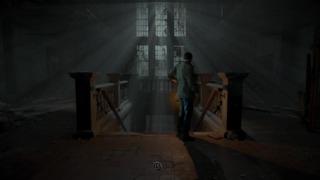
The writing does eventually struggle free of this genericness. Later into the game, we see the characters hauling up unexpected humanising traits that lurk beneath their stereotypical surface. The typically nervous and easily flustered Ashley can be brave or even ruthless when the situation calls for it. Matt, who initially appears only to want to pacify his girlfriend mindlessly, shows pent-up frustration with her when she finds herself in a position where she has to listen to him. These reveals not only lend the characters depth by giving them more dimensions but also by casting new light on the sides of their personalities they initially show. Our first impression of Mike is that he's just a goofball bro, and when the game shows him being very serious, it's mostly when he's alone, suggesting that sadly, he only knows how to communicate with other people in a superficial, disengaged manner. Then there's Jess who touts confidence and obsession with her appearance from early in the game's runtime but later expresses that she feels insecure about her looks, telling us her vanity is an overcompensation to keep her from getting hurt. Of course, once this humanisation of the characters occurs, they aren't so generic, and the events of the game become less predictable, meaning you can't use this little foreknowledge trick nearly as much. It's worth the trade-off, but it does also raise the question of why the game feels the need to string you along with the one-note versions of the party for as long as it does.
___
Before, you could say the generic characters were in service of rewarding players' genre knowledge, but the game is comfortable with bucking horror stereotypes from about halfway through, so why not just leave stereotypes out of the game entirely? Creative Director Will Byles explains that the game runs with a highly familiar story from early on “so players could say, ‘OK, I get it, you’re doing a teen horror.’". How we view this statement depends on how narrowly we define "teen horror", but no interpretation leads to a substantial justification of derivative characters. If we think about the term broadly, "teen horror" refers to stories about naive teenagers finding out who they are while under threat from something terrible, but Until Dawn doesn't have to follow its parents in this genre so closely to occupy that space, there is room for more original entries in the field. If we want to define "teen horror" more narrowly, as a set-in-stone formula with very specific tropes, then it doesn't seem right to make your work a "teen horror" at all, it's running headlong into a formulaic setup. Byles goes on to say "the second reason [...] was to make them all slightly unpleasant and flawed, because I genuinely believe it’s a much better way to get people to empathise". I don't believe there's a link between making characters generic and making them flawed. There are plenty of original ways to show people aren't perfect. When you use the techniques that thousands of pieces of other media have before, you don't make your audience empathise with your characters; you make it obvious that your characters are just fictional and were dreamed up by a writer in a room somewhere because they follow the patterns we identify with fiction.
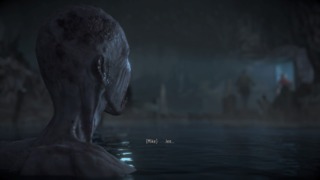
An alternative explanation comes courtesy of Reznick, who says that the game was originally meant to be more of a satire but that after a lot of reconfiguring, transmogrified into earnest horror.[1] The game's journey from scary movie send-up to authentic panic thriller may also be why Until Dawn seems to contain dual personalities. Around the two-thirds mark, it transforms from a schlocky B-movie romp, grounded in something resembling reality, to a harsh supernatural rollercoaster. Josh isn't the killer, just a psychologically troubled prankster, but there is a real danger on the mountain, and it's the Wendigo. This leap from one plotline to the other is messy, needless, and splits the game into two underworked stories instead of one fully-realised one. However, to the extent that we can separate the "Wendigo" portion of the game from the rest, it works, mostly because the Wendigo are a much better horror villain than Josh is.
Don't get me wrong, when he's not locked into his "Psycho" persona Josh Washington is one of the Until Dawn's most compelling characters. For all the status that the big name acting talent lends the game, only Rami Malek and Peter Stormare are given the script to make full use of it. Their emoting is also an example of how the game's often criticised uncanny facial animations can lend a suitable sense of unease to scenes. In a long-running tradition of fictional psychiatrists, A.J. Hill helps develop Josh as a character by delving down into who he is psychoanalytically, but it's the twist that Hill is only in Josh's head that elevates Josh to a character that engenders empathy. Unlike some horror villains, Josh is not just consumed by vindictiveness, he's also mentally ill, "Off his meds". It can be hard to understand the thought processes of a mentally ill character, but the scenes with Hill give us a window into him. Josh is trying not to be a monster; he's trying to appeal to some part of himself that helps him process and explore what troubles him, with that part being represented by Hill, but this region of his psyche is dysfunctional and deranged, eventually leaving him entirely. This also sets Josh up perfectly to be the game's most tragic character, being left alone in a crazed stupor and attacked by Wendigo which in turn sets up the Wendigo as a gruesome enemy for the game's next act.
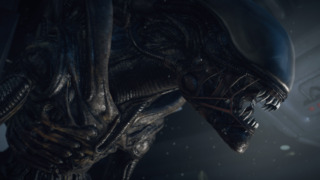
There's not nearly as much to explore in "Psycho" Josh, however. Good horror villain designs convey what's meant to be scary about that villain. For example, the brutal masochism of the cenobites in Hellraiser is represented through the self-torture devices they wear, and the ruthless animosity of the alien in Alien is reflected through its sharp teeth and dinosaur-like appearance. Josh just looks like a Halloween costume thrown together out of whatever someone had hanging around at the time. The diegetic reason for this is that he is not a calculated master of murder and that he's just trying to replicate what a killer looks like from the horror films he knows. However, it still leaves him with a character design that communicates nothing about the kind of villain he's meant to be. Josh's methods of attack can also fail to cultivate a single, solid theme around him.
His goal is to exploit betrayal and public spectacle; it's what he sees as having gotten his sisters killed, so it's what he unleashes on other people. It's there in his theft of Sam's clothes and more tangibly in the Saw-inspired traps where he forces his friends to choose who among them should die. The design for the first trap feels a little wonky, though. The game presents you with an unmarked lever that you can pull in the direction of either would-be victim, but whatever direction you yank it, it's the fake Josh that gets the axe. Once you've seen that it was all rigged near the end of the game, you understand that you weren't choosing which of your friends should die and that the results of your decision were arbitrary, undermining any sense of betrayal. In fact, you may not feel you've betrayed anyone even during the scene because the lever isn't labelled and may kill someone other than who you meant it to.
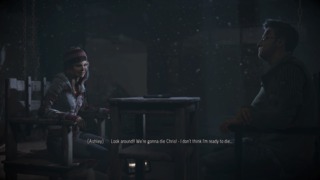
It seems like such a waste because this is one of only two Jigsaw routines Josh pulls on the group and this mode of attack is potentially gripping because it has the power to reflect his values and test the loyalties of the characters. Josh's other ambushes on the teens have little to do with the themes that are meant to drive his psychology and fail to set him apart from the overflowing pool of bland slasher villains. When Josh pits the characters against each other in public shows of their allegiance, it says something. When he just runs after characters trying to jab them with a syringe or punch them in the face, it says nothing. Although, this is a relative improvement on a lot of the game which doesn't even have our antagonist showing up to do the scaring.
Until Dawn has quite a few jump scares in it, and we can have a discussion about the legitimacy of jump scares as a technique, but if they work, then it's because they can add some grandiosity to whoever or whatever is meant to be the source of fear in the piece of media. For most games and films, this means that the monsters do the jump scaring because it makes them scarier. With that in mind, it's surprising that Until Dawn uses so many jump scares that are not directly conducted by Josh. Instead, the scares are mostly pulled off by trivial characters and objects that are peripheral to the main plotline or at least appear to be at the time. It's animals flapping at people or Matt jumping up in front of the lens of a telescope.
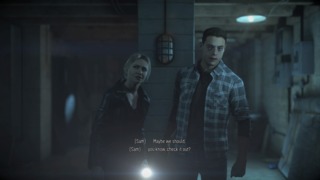
It makes sense why "The Psycho" isn't involved in a lot of the early scares in the game, the experience needs to carefully ramp up to introducing what looks like a literal serial killer. However, this also raises questions of whether the early game is the right place for these scares at all and it doesn't rid of the game of this noticeable misallocation of startling moments. Supermassive Games don't seem to understand that isolated scary moments for the sake of themselves are not the ideal goal of horror and that there might be a larger sense of dread that needs support. See, the developer tweaked the scares for their game by having QA testers play through sections while hooked up to biometric sensors. When those sensors didn't report dramatic enough reactions to scares, they altered the relevant scenes to make them more frightening. It's not necessarily a bad development practice in itself, but if what design director, Tom Heaton, has said is to be believed, they were deliberately discarding all other player feedback to focus only on this data. To quote, "Being scientific about it means we strip out peoples' opinions about whether things are working or not. We've got data, and we look at the data".[2] Heaton describes a streamlined method for building a game that makes people jump in the moment, but it's also a stubbornly reductionist one. When you dedicate effort to improving immediate tension but not peoples' deeper thoughts on your game's horror, you end up with a shallow game with only short-term thrills. Fine-tuning your jump scares is not a replacement for quality writing and directing. If it was, we could substitute horror reviews with biometric readouts. The only possible reprieve for Supermassive is if this description of their QA process was misleading.
The Wendigo themselves are an example of how to do it right. They're not just about jump scares, and the game gets a better handle on them than it does "The Psycho". While the Wendigos' motive and methods of attack are more simplistic than Josh's, they are well-established from the moment the Wendigo are revealed, and they don't deviate from them. This intersects with these monsters just having a better character design than our previous antagonist did. Their look and behaviour are most likely lifted from the monsters in the 2005 British horror film The Descent, but that doesn't make them any less suited to Until Dawn. While "The Psycho" looks like the general-purpose enemy you might encounter in a Steam Greenlight shooter, the Wendigos' character design that has them wearing their origin on their sleeve. Any human that eats another on Blackwood Mountain becomes a Wendigo, and as such, the Wendigo constitute a representation of the metaphorical monster you become when you give into hunger and engage in cannibalism. This is why it's right that they look like mangled humans and why they're all about trying to consume any prey they can find, with these gaping maws of long, jagged teeth.
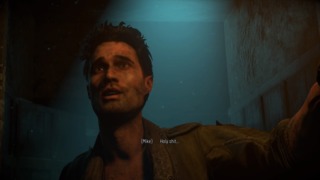
There is also a better-sustained sense of the Wendigo as a source of threat than there is with "The Psycho". For their portion of the game, these monsters get relatively more time on-screen, the lethality of their attacks is openly demonstrated, and even when they're not right in front of you, their echoing screams let you know they're still lurking in the background. For all the praise this game has gotten for making it feel like you can die at any time, the majority of these moments of mortal risk are in the last three chapters of the game, once the Wendigo start running the show. This is likely because too many possible deaths earlier on would have landed Supermassive with an unmanageable number of different branches for the script and may have resulted in a misshapen story.
These monsters are also not just keenly designed and positioned well relative to other story elements; the game makes them intimidating through their animation and behaviour. They are at their best when they're in motion, with their sped-up movements making them feel uncomfortably uncanny and underscoring their adeptness for predation. Their handicap of only being able to track their prey by movement makes them integrate wonderfully with the PS4 controller's accelerometer. The various "Don't Move" sections could well represent the most affecting use of the PlayStation's motion controls to date, and it's a fair question to ask how Supermassive manages to surpass so many other developers at making motion controls enjoyable here.
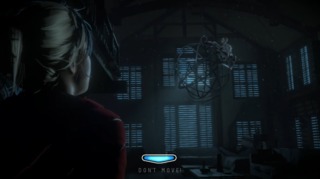
One answer is that other games using motion controls tend to see them as the primary or sole way the audience should play but Until Dawn doesn't think they're the right tool for every job, recognising that for 99% of the time traditional interfaces are a preferable way to control characters. Many games that use motion controls also don't closely synchronise the actions you perform using the controller with the actions that the characters on-screen are performing (see Brian Crecente's essay on this for a more thorough analysis) but the "Don't Move" scenes do. When you need to a character to stay still, you literally have to stay still yourself. It creates these very physical moments of vulnerability in the face of the Wendigo, and it's a strong example of how the chapters from number 8 onwards connect their scares with their antagonist while the earlier chapters just can't be bothered to do so.
For as much the Wendigo are an improvement over "The Psycho", however, we have to talk about the jarring jump the game makes from one antagonist to the other. Because everything in this third act is so much darker than what's come before, the game performs a complete 180 tonal turn. It's a corny B-movie homage that just blinks and suddenly becomes a creature feature where the characters are in extreme mortal peril. The early game fails to lay a foundation for the late game and the late game breaks from the early game in a way that keeps it from feeling like the early game is properly resolved. Based on statements made by some of the creatives on the project, it would seem that this sudden elevation in how earnestly scary the game gets is a mistake and that they believed they were making top-to-bottom, a more consistently terrifying game.[2]
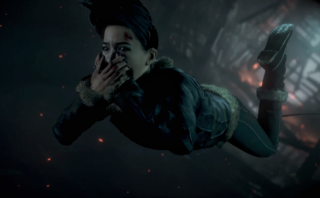
There's not just an emotional disconnect between these two sections of the game either; there's a thematic one too. I've already mentioned the theme of cannibalism in relation to the Wendigo, but that cannibalism is a conduit to larger themes of environmentalism and respect for nature. To understand these themes and their origins, let's look at co-writer Larry Fessenden's use of the Wendigo in his earlier films: Wendigo and The Last Winter. In the opening of Wendigo, we meet George, a man setting out on a family vacation who hits a deer on an unfamiliar road, angering a group of local hunters. By the end of the film, George has been killed at the hands of a Wendigo, and one of the hunters, Otis, has been severely injured after being chased onto a local road by a Wendigo. In The Last Winter, we follow a group of oil company employees embarking on a construction project in the Arctic. Though an environmentally destructive aspect of the project becomes apparent, the head of the team decides to push ahead anyway, there is some philosophising about nature itself turning against man, and the vengeful spirits of the Wendigo kill most of the crew.
In the real world, the Wendigo originate from Native American mythology, and in these films, Fessenden follows their cultural practice of using the Wendigo as a creature that seeks revenge against those who harm nature and violate Native American ethics, particularly when that damage and violation comes from western or privileged interests. The Wendigo are intended to be scary in that they reflect the greedy, butcherous nature of western invasion back at westerners. They're an attempt to make us sympathise with Native Americans by showing what it's like to have your people hunted down by this unstoppable, consumptive force. It's carried forwards into Until Dawn.
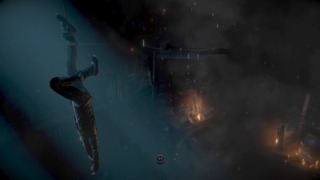
The game's setting of Blackwood Mountain was once home to Native Americans, but miners drove out the tribe and sucked the land dry of its natural resources in a blatant disregard for the sanctity of nature that the natives believed in. Years later, a group of rich teens head out onto the same Native American land, land on which a wealthy family has built their cabin. In both cases, the groups of people involved in taking control of the Native American land are later tormented by the Wendigo and just to ram the point home, the founder of the mine and the family who owns the cabin bear the surnames Jefferson and Washington, respectively. Then there are the snowscape settings Fessenden consistently places the Wendigo in. These inhospitable environments that choke out plant and animal life are isolating, but they also represent the environmental destruction present in these stories. For more on the symbolism of the Wendigo and Fessenden's previous use of them, I recommend Grace L. Dillon's essay Windigo.
This is all so much smarter than what the game was doing with Josh. Until Dawn builds a backstory that more than capably supports the Wendigo and uses the monster to make us empathise with a historically subjugated race. However, this has nothing to do with Until Dawn's other plotline which is meant to be about teenage drama and disloyalty to friends, and as great as the Wendigo are when they work, some scenes make even them thematically foggy. At a number of key points during the game, we (and therefore the characters) have the choice to act peacefully or aggressively towards animals, e.g. Attacking or ignoring elk, throwing a snowball at a bird or leaving it be. If you choose to be peaceful towards the creatures, then it corrupts the symbolism behind the Wendigo. The Wendigo attack and embody those who oppose the preservation of nature, but here they can be shown doing the opposite and attacking those who exist in harmony or even friendship with the animals of the mountain. Not to mention that one of the reasons that Josh is such an intermittent presence in the game is that, to teach us about the Wendigo, the game keeps derailing to send us off on quests to fetch backstory about them. The two plotlines end up interrupting each other instead of working in tandem with each other.
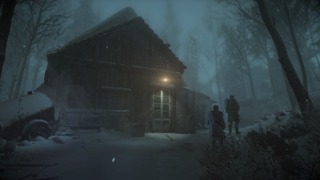
It's a shame that some parts of the story feel so alienated from others because there are elements of Until Dawn which hold together with a lot more stability. There's Jason Graves' reliably doom-laden soundtrack, and there's this pervading blue colour palette that the game keeps returning to. A lot of horror games have concluded that the only correct way to make a place look actively unpleasant to inhabit is by making it grotty and filling it with lots of browns and greys with little other visual treatment. While you can feel that to an extent in Until Dawn locations like the mines or sanitorium, overall, the game's decision to include a lot of sections in the lodge and the snow and to light them with this thick blue create a unique and oppressive atmosphere. It's solemn but not so solemn that the game looks like this grimdark horror that it's not.
A recurring, but by no means universal pattern in Until Dawn is that it has a lot of concepts that aren't bad when they're static or when they're on paper, but that when it tries to churn all of them into motion, it starts falling apart. The visual and audio style, the ways collectables are handled, and at least one of the plotlines provide impact, but one thing the game is particularly bad about is time management. Until Dawn is a piece of media that's roughly eight hours long with a cast of eight playable characters and two complex interlocking plotlines. It's trying to fit a lot of storytelling into relatively little time, meaning the game should be going in all-guns-blazing on endearing its characters to the player, explaining its plot, and making the audience fear the game's malevolent forces. That doesn't mean it cannot or should not have quiet moments; they undeniably contribute to the experience, but it does mean the game's not in a position to waste time and resources, and yet it does.
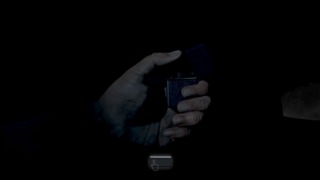
Until Dawn repeatedly pulls off jump scares that mean nothing to the larger game, it gets distracted from keeping its villain in-frame, it has sections of exploration where it doesn't feel like enough of the environment was filled in, and toys about with purposefully generic versions of the characters for much of its runtime even when it has more nuanced incarnations to roll out. You could even argue that Until Dawn's greatest mismanagement of time is letting a roughly five-hour Netflix horror quality plotline interrupt a fierce, culturally grounded creature horror plotline. It's hard not to think about what Until Dawn could have been if it just sat down and focused. Thanks for reading.
Additional Sources
- How Until Dawn Ended Up With A 10,000 Page Script
- Until Dawn On-Disc "Behind the Scenes" Content